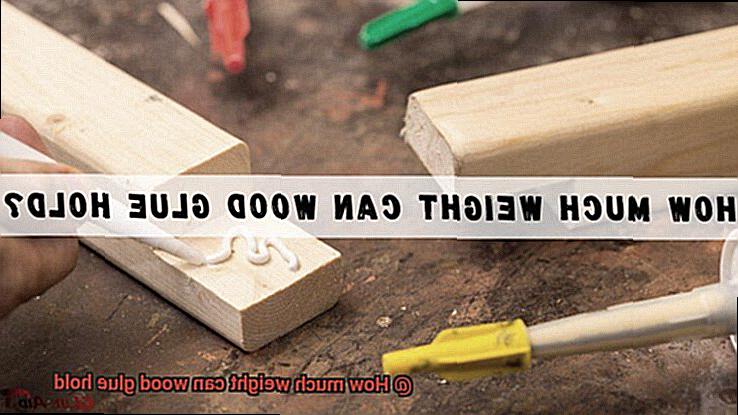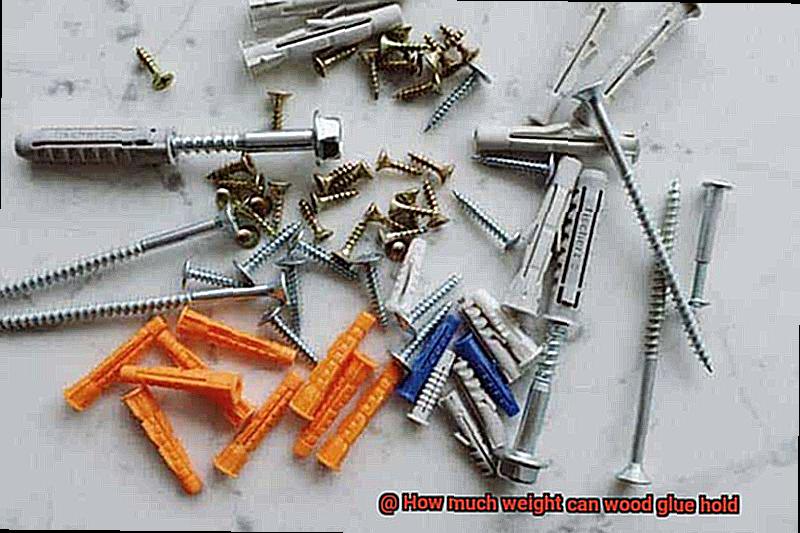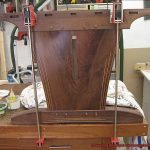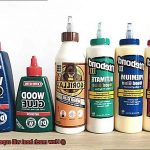Ever wondered just how strong wood glue really is? Well, get ready to be blown away.
Wood glue isn’t just your average adhesive – it’s a superhero in the world of woodworking. It’s been holding things together for ages, and let me tell you, it’s no weakling.
Depending on the brand and type you choose, wood glue can hold an impressive amount of weight. We’re talking bond strengths of up to 3,000 pounds per square inch.
That means it can easily handle heavy-duty projects like furniture, cabinets, and even structural components. Stick around as we dive into why wood glue is the ultimate go-to adhesive for all your woodworking needs.
Plus, I’ll share some handy tips along the way that’ll have you gluing like a pro in no time.
What is Wood Glue?
Contents
- 1 What is Wood Glue?
- 2 Factors that Affect the Weight-Bearing Capacity of a Glued Joint
- 3 Different Types of Wood Glue
- 4 The Role of Surface Area in Determining Weight Capacity
- 5 Quality and Application of Glue Matter
- 6 Conditions That Can Impact Strength and Durability
- 7 Tips for Ensuring Maximum Strength and Stability of a Glued Joint
- 8 Conclusion
Wood glue is like a magic potion for woodworkers, transforming simple pieces of wood into sturdy, long-lasting creations. Whether you’re a seasoned carpenter or a beginner DIY enthusiast, understanding the wonders of wood glue is essential. In this blog post, we’ll explore the ins and outs of wood glue, its versatile uses, and how to make the most of this incredible adhesive.
The Science Behind Wood Glue:
Wood glue, also known as carpenter’s glue or PVA glue, is an adhesive specially formulated to bond wood surfaces together. Its secret lies in its ability to penetrate the wood fibers, creating a bond that can often be stronger than the wood itself. When applied, the glue seeps into the pores and interlocks with the cellulose fibers of the wood. As it dries, it hardens, forming a tight grip on the wood and ensuring a solid connection.

Types of Wood Glue:
Wood glue comes in various forms to suit different woodworking needs. Liquid wood glue is the most common type, easily applied and spreading evenly on the wood surface. Gel and paste forms are thicker options that work well for vertical surfaces or filling gaps. Each form has its advantages and is suitable for different woodworking applications.
Uses of Wood Glue:
Wood glue’s versatility makes it indispensable in woodworking projects. Here are some common applications:
- Joinery: Wood glue excels at bonding different pieces of wood together in joinery work, ensuring strong and durable connections for furniture, cabinets, and wooden structures.
- Repairs: Fix broken or damaged wooden objects using wood glue. It can mend cracked furniture legs, reattach loose joints, or repair split wooden boards.
- Veneering: Enhance the appearance and durability of your projects by using wood glue to apply veneer sheets to surfaces. The glue ensures a smooth and secure bond.
- Laminating: Wood glue is essential for laminating thin layers of wood to create thicker, more stable panels. This technique is commonly used in tabletops, countertops, and flooring.
Tips for Using Wood Glue:

To make the most of wood glue’s power, follow these tips:
- Clean and dry surfaces: Ensure surfaces are free from dust or debris for better adhesion and a stronger bond.
- Apply a thin layer: Evenly apply a thin layer of wood glue on both surfaces using a brush or applicator. Excessive glue can weaken bonds or cause excessive squeeze-out.
- Clamp it down: Firmly press the surfaces together after applying the glue and use clamps to hold them in place until the glue cures. This maximizes contact and pressure for a strong bond.
Factors that Affect the Weight-Bearing Capacity of a Glued Joint
Woodworking is an art that demands a deep understanding of the intricate factors that contribute to the weight-bearing capacity of a glued joint. In this blog post, we will explore the essential elements that converge to create durable and enduring woodwork. From the choice of wood to the application process, each factor is a vital cog in the wheel of crafting a strong bond capable of defying time’s test.
Type of Wood:
The foundation of any glued joint lies in the selection of wood. Hardwoods like oak, maple, or mahogany reign supreme with their unwavering strength and density. These woods provide a formidable base for glue, ensuring an unyielding bond. On the other hand, softwoods such as pine or cedar, though accessible and affordable, may lack the desired weight-bearing capacity and should be employed cautiously in load-bearing applications.
Surface Preparation:
Achieving a robust bond between wooden pieces necessitates impeccable surface preparation. The surfaces to be joined must be pristine – devoid of contaminants like dust, oil, or wax – and dry. Sanding the surfaces lightly not only enhances adhesion but also augments surface area, fortifying the bond’s holding strength.
Glue Type:
The glue chosen for a joint’s inception holds immense sway over its success. A wide array of glues exists, each boasting unique properties. PVA (polyvinyl acetate) glue finds favor in woodworking projects due to its tenacious bonding capabilities and user-friendly nature. For heavy-duty load-bearing joints, epoxy glue emerges as the champion, offering unparalleled strength and durability. Understanding each glue’s characteristics empowers woodworkers to select the most suitable option tailored to their specific projects.
Glue Application:
The artistry of glue application significantly impacts joint strength. Consistency is key – an even layer of glue on both surfaces being joined ensures a sturdy and uniform bond. Excessive glue breeds squeeze-out, weakening the connection, while insufficient glue coverage diminishes holding capacity. Employing brushes or rollers to spread adhesive evenly guarantees proper application and amplifies joint integrity.
Clamping Pressure:
The precise application of clamping pressure during the glue-up process is paramount to fostering a robust bond. Adequate pressure expels excess glue, allowing the adhesive to penetrate wood fibers and establish an unbreakable union. Insufficient clamping pressure yields feeble joints susceptible to buckling under load. Leveraging clamps or weights to maintain unwavering and uniform pressure until the glue cures entirely ensures optimal strength.
Different Types of Wood Glue
Wood glue is a woodworker’s best friend when it comes to creating strong and durable joints. However, with so many different types of wood glue available, it can be challenging to choose the right one for your project. In this article, we will explore the world of wood glue and discuss the strengths and weaknesses of each type, helping you make an informed decision.
PVA Glue: The Versatile Workhorse
PVA glue, also known as yellow glue or carpenter’s glue, is the most common type of wood glue used in woodworking projects. It offers a strong bond and is suitable for general woodworking tasks. PVA glue comes in various forms, including white glue and liquid hide glue. White glue is perfect for everyday projects, as it dries clear and is easy to clean up. On the other hand, yellow glue provides a stronger bond due to its longer drying time, making it ideal for projects that require extra strength.
Epoxy Glue: The Ultimate Strength
When exceptional strength is required, epoxy glue is the go-to choice. This two-part adhesive consists of resin and hardener that must be mixed before application. Epoxy glue creates a bond that can withstand heavy loads and is ideal for structural applications or bonding different materials together. It also has excellent resistance to chemicals and temperature extremes, making it suitable for outdoor projects or those subjected to harsh conditions.
Polyurethane Glue: The Gap-Filling Wonder
If you’re working on projects with gaps or irregular surfaces, polyurethane glue (commonly known as Gorilla Glue) is your best bet. As it cures, polyurethane glue expands to fill gaps, creating a strong bond. Its foaming action also helps to create a waterproof seal, making it suitable for outdoor projects or those exposed to water. However, polyurethane glue requires moisture to cure properly, so it’s important to dampen the surfaces before applying the glue.
Cyanoacrylate Glue: The Quick Fixer
For small-scale woodworking projects or situations where speed is essential, cyanoacrylate glue (super glue) comes to the rescue. It dries quickly and forms an instant bond. However, keep in mind that it might not provide the same level of strength as other types of wood glue. Super glue is ideal for bonding delicate or hard-to-clamp pieces together, but it may not be suitable for load-bearing applications.
The Role of Surface Area in Determining Weight Capacity
Wood glue is an essential tool for any woodworker, holding projects together with strength and durability. But have you ever considered how the surface area of the wood glue impacts its weight capacity? Let’s explore the captivating realm of surface area and its role in determining weight capacity.
When wood glue is applied, surface area encompasses the total area of the surfaces in contact with each other. Though it may seem insignificant, surface area plays a vital role in determining how much weight the glue can bear. When two surfaces are bonded with wood glue, the adhesive strength is distributed across the entire surface area. In other words, the larger the surface area, the greater adhesive strength is available to support weight.

Imagine trying to lift a heavy object with just one hand. It would be a struggle. However, if you distribute the weight evenly by using both hands, it becomes much easier. The same principle applies to wood glue. A larger surface area allows for a higher weight capacity because more adhesive strength is available to bear the load.
However, it’s not just about size; the type of bond being formed also affects weight capacity. For instance, a butt joint (where two pieces of wood are joined at their ends) has less surface area compared to a lap joint (where one piece overlaps another). Consequently, a lap joint possesses a greater weight capacity than a butt joint.
Additionally, cleanliness and proper clamping are crucial factors to consider. Ensuring that surfaces are free from contaminants and debris allows for better contact between the wood and glue, maximizing surface area and weight capacity. Adequate clamping during the curing process maintains consistent pressure on surfaces, promoting optimal bonding and maximizing weight capacity.
While surface area is an important factor in determining weight capacity, it is not the sole consideration. The type and quality of the wood glue used, as well as environmental conditions, can also influence bond strength and overall weight capacity.
Quality and Application of Glue Matter
Step into the world of woodworking, where glue reigns supreme as the unsung hero of weight-bearing capacity. In this article, we will unravel the mysteries behind glue quality and application, exploring how these factors can make or break your projects. So, grab a cup of coffee and join us on this fascinating journey.
The Glue Quality:
When it comes to glue selection, quality is paramount. For wood projects, polyvinyl acetate (PVA) glue takes the crown. Its robust bonding properties ensure a strong hold that won’t let you down. Not all glues are created equal, so choose one specifically designed for wood projects to achieve optimal performance.
The Application Process:
The devil is in the details when it comes to glue application. To maximize weight-bearing capacity, follow these essential steps:
Even Layer: Apply an even layer of glue to ensure maximum coverage and an uninterrupted bond.
Wood Type Matters:
Different woods have varying levels of porosity and density, directly impacting the adhesive’s ability to penetrate and form a solid bond. Hardwoods generally offer higher weight-bearing capacity due to their denser structure compared to softwoods.
Temperature and Humidity Considerations:
Environmental factors can influence the strength of your bond. Cold temperatures slow down curing time, while warm temperatures speed it up. High humidity levels can affect drying time and overall bond strength. Always follow the manufacturer’s recommendations regarding temperature and humidity conditions for optimal results.
The Limitations of Glue:
While wood glue can hold a significant amount of weight, it’s important to note that it is not as strong as mechanical fasteners like screws or nails. Glue provides a strong bond between two surfaces but may not have the same sheer strength as metal or other materials. Consider additional reinforcement for projects with higher load requirements.
Conditions That Can Impact Strength and Durability
Strength and durability are crucial factors to consider when using wood glue for woodworking projects. Several conditions can impact the quality of glue joints, and understanding these factors is essential for achieving reliable and long-lasting bonds.
Temperature plays a significant role in the performance of wood glue. Applying and curing glue within the recommended temperature range is vital for optimal bonding. Glue applied in temperatures that are too low or too high may not bond properly or become brittle over time. Following the manufacturer’s guidelines regarding temperature is crucial to ensure strong and durable bonds.
Humidity levels also influence the strength and durability of wood glue bonds. High humidity can slow down the curing process, making it take longer for the glue to fully bond. Conversely, low humidity can cause the glue to dry too quickly, resulting in weaker bonds. It is important to consider the humidity levels in the working environment and make adjustments accordingly.
Proper surface preparation is essential for achieving strong and durable bonds. Wood surfaces must be clean, dry, and free from contaminants such as dust, grease, or old glue residue. Sanding the surfaces and ensuring a tight fit between the pieces being glued together can maximize bonding strength.
The type of wood being used impacts the strength of glue joints. Hardwoods like oak or maple have higher densities and provide stronger bonds compared to softer woods like pine or cedar. Additionally, considering the porosity of the wood is crucial since it affects how well the wood absorbs the glue and forms a strong bond.
Applying adequate clamping pressure is another crucial factor for achieving strong and durable glue joints. The amount of pressure required depends on factors such as wood type, joint design, and the specific wood glue being used. Insufficient pressure can result in weak bonds, while excessive pressure can squeeze out too much glue, leading to weakened joints.
Lastly, age and storage conditions of wood glue can impact its effectiveness. Checking expiration dates and storing the glue in a cool, dry place is essential to ensure maximum strength and durability.
Tips for Ensuring Maximum Strength and Stability of a Glued Joint
Creating strong and stable joints is essential in woodworking projects, and gluing is a popular method for joining pieces of wood together. To ensure maximum strength and stability, it is important to follow specific tips and techniques. In this article, we will explore key factors that contribute to the strength and stability of a glued joint.
Choose the Right Glue:
Selecting the appropriate type of wood glue is crucial for achieving a strong bond. Different glues, such as PVA glue, epoxy glue, and polyurethane glue, have their own strengths and weaknesses. Choose the glue that is suitable for your specific project to ensure optimal results.
Prepare the Surfaces:
Properly preparing the surfaces that will be joined is essential. Thoroughly clean the surfaces to remove any dirt or grease. Lightly sanding the surfaces creates a rough texture that allows for better glue adhesion.
Apply the Glue Correctly:
Applying the right amount of glue is key to a strong joint. Too little glue can result in weakness, while too much can create a messy joint. Follow the manufacturer’s instructions for the recommended amount of glue to use. Spread the glue evenly over the entire surface to ensure maximum strength.
Clamp the Joint:
Applying pressure during the drying process is crucial for creating a strong bond. Use clamps to hold the glued surfaces tightly together. This eliminates gaps and ensures proper glue setting. Strategic placement of clamps along the joint ensures even pressure distribution.
Allow Proper Drying Time:
Patience is vital when it comes to drying time. Allow sufficient time for the glue to dry completely before subjecting any stress on the joint. The drying time varies depending on factors like temperature and humidity, so follow the manufacturer’s instructions for accurate guidance.
Consider Reinforcing the Joint:
In some cases, reinforcing the glued joint can provide extra strength and stability. Techniques like doweling, splines, or using mechanical fasteners like screws or nails can add additional support to the joint. Carefully plan and execute these reinforcements to maintain the joint’s integrity.
Also Read: How Much Weight Can Hot Glue Hold?
Conclusion
When it comes to the question of how much weight wood glue can hold, the answer may surprise you.
Wood glue, also known as carpenter’s glue or PVA glue, is a powerful adhesive that can withstand significant amounts of pressure. In fact, wood glue has been tested to hold weights ranging from 1,000 pounds to 4,000 pounds per square inch (psi) of bond strength.
Whether you’re working on a small woodworking project or constructing something larger like furniture or cabinets, wood glue is an essential tool that can handle the heavy lifting.






